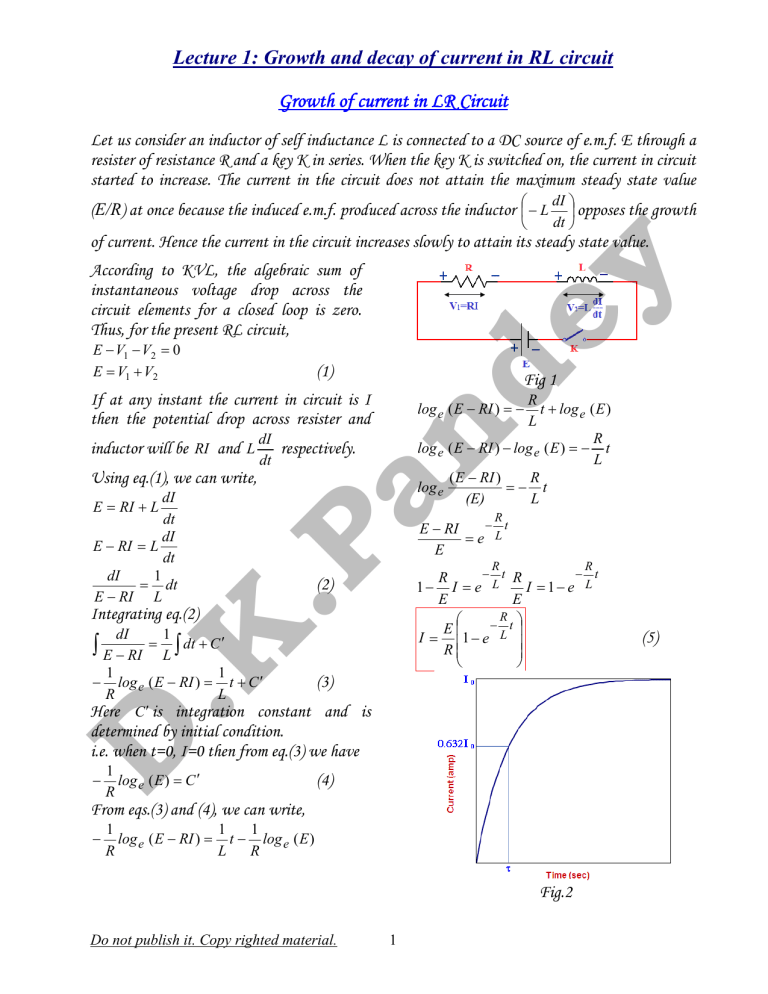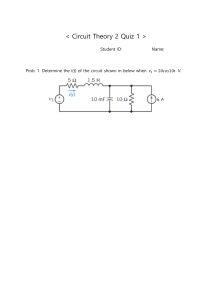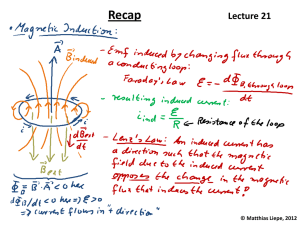
Lecture 1: Growth and decay of current in RL circuit
Growth of current in LR Circuit
Let us consider an inductor of self inductance L is connected to a DC source of e.m.f. E through a
resister of resistance R and a key K in series. When the key K is switched on, the current in circuit
started to increase. The current in the circuit does not attain the maximum steady state value
dI
(E/R) at once because the induced e.m.f. produced across the inductor ⎛⎜ − L ⎞⎟ opposes the growth
⎝
dt ⎠
E − V1 − V2 = 0
E = V1 + V2
(1)
inductor will be RI and L
Using eq.(1), we can write,
dI
dt
dI
E − RI = L
dt
dI
1
= dt
E − RI L
R
t + log e ( E )
L
R
log e ( E − RI ) − log e ( E ) = − t
L
( E − RI )
R
log e
=− t
(E)
L
log e ( E − RI ) = −
dI
respectively.
dt
R
.K
.P
E = RI + L
Fig 1
an
If at any instant the current in circuit is I
then the potential drop across resister and
de
According to KVL, the algebraic sum of
instantaneous voltage drop across the
circuit elements for a closed loop is zero.
Thus, for the present RL circuit,
y
of current. Hence the current in the circuit increases slowly to attain its steady state value.
(2)
Integrating eq.(2)
dI
1
∫ E − RI = L ∫ dt + C ′
1
1
(3)
log e ( E − RI ) = t + C ′
R
L
Here C ′ is integration constant and is
− t
E − RI
=e L
E
R
R
− t R
− t
R
1− I = e L
I = 1− e L
E
E
R
⎛
− t ⎞⎟
E⎜
I = ⎜1 − e L ⎟
R⎜
⎟
⎠
⎝
−
D
determined by initial condition.
i.e. when t=0, I=0 then from eq.(3) we have
−
1
log e ( E ) = C ′
R
(4)
From eqs.(3) and (4), we can write,
−
1
1
1
log e ( E − RI ) = t − log e ( E )
R
L
R
Fig.2
Do not publish it. Copy righted material.
1
(5)
Lecture 1: Growth and decay of current in RL circuit
Since , the steady state current or maximum
current (I0)= E/R
And dimension of L/R = dimension of time;
L
= τ = inductive time constant
R
{
I = I 0 1 − e −t / τ
Hence eq.(4) becomes as,
When t=τ then from above eq., we can write
{
I = I 0 {1 − (1 / 2.718)}
I = I 0 {1 − 0.368}
I = 0.632 I 0
I = 0.632 I 0 = 63.2% I 0
Thus the time constant for the RL circuit is
the time in which the current increases up to
63.2% of maximum current.
an
Eqs. (5) and (6) are called as expression of
growth current in RL circuit.
These expressions indicates that(1) Initially the current in the circuit is zero.
(2) It increases exponentially following
expression (1 − e −t τ ) .
(3) After infinite time current reaches to its
steady state value (I0).
}
I = I 0 1 − e −1
I = I 0 {1 − (1 / e)}
(6)
de
t
⎛
− ⎞⎟
⎜
τ
I = I 0 ⎜1 − e ⎟
⎟
⎜
⎠
⎝
}
y
Say,
Inductive Time constant
The Growth of current in RL circuit follows
following equation.
Decay of current in LR Circuit
.K
.P
Let us consider a charged inductor of self inductance L is connected to a resister of resistance R
through a key K in series. When the key K is switched on, the inductor discharges through resister.
The current in circuit started to decrease due to loss of inductive energy through resister.
According to KVL, the algebraic sum of
instantaneous voltage drop across the
circuit elements for a closed loop is zero.
Thus E − V1 − V2 = 0
E = V1 + V2
Here E=0, Thus V1 + V2 = 0
D
(1)
If at any instant the current in circuit is I
then the potential drop across resister and
inductor will be RI and L
dI
respectively.
dt
Using eq.(1)
RI + L
dI
=0
dt
dI
L = − RI
dt
dI
R
= − dt
I
L
Integrating eq.(1)
dI
R
= − ∫ dt + C ′
I
L
R
(3)
log e I = − t + C ′
L
Here C ′ is integration constant and is
∫
determined by initial condition.
i.e. when t=0, I=I0 then from eq.(3) we have
log e I 0 = C ′
(4)
From eqs. (3) and (4), we can write,
(2)
Do not publish it. Copy righted material.
Fig.1
2
Lecture 1: Growth and decay of current in RL circuit
log e I = −
I
R
log e
=− t
I0
L
I = I0
when A is connected to C then the charged inductor
discharges through resister.
R
t + log e I 0
L
C
R
− t
I
⇒
=e L
I0
R
L
10Ω
50H
(5)
Since , dimension of L/R = dimension of time;
2V
y
In the Given circuit,
Maximum current= I 0 = E / R = 2 / 10 = 0.2 amp
Time constant = τ = L / R = 50 / 10 = 5 sec
The calculated growth and decay of current in the
given circuit are presented in the Table A and is
shown in Fig.A.
Table A
de
Hence eq.(5) becomes as,
I growth
(amp)
I decay
(amp)
0
5
10
15
20
25
30
0
0.126424
0.172933
0.190043
0.196337
0.198652
0.199504
0.2
0.073576
0.027067
0.009957
0.003663
0.001348
0.000496
.K
.P
an
t
(sec)
Fig. A
0.2
0.18
0.16
Inductive Time constant
The expression for decay of current in LR
circuit is
0.14
−t / τ
When t=τ then from above eq., we can write
1
1
I = I0 e = I0 = I0
= 0.368 I 0
2.718
e
I = 0.368 I 0 = 36.8% I 0
D
−1
0.12
Growth
0.1
Decay
0.08
0.06
0.04
0.02
0
0
5
10
15
Time (sec)
20
25
30
The above Table and Figure indicate that when t=5τ
then the growth current increases up to
approximately maximum value I0 and decay current
decreases up to zero value.
Thus the time constant for the RL circuit is
the time in which the current decays from
steady state value to 36.8% of maximum
current.
Note A: In the following LR circuit, when A is
connected B then current rises in the circuit and
inductor charges through resister. Furthermore,
Do not publish it. Copy righted material.
Current (amp)
Fig.2
I = I0 e
B
E
L
Say, = τ = time constant
R
(6)
Eqs. (5) and (6) are called as expression for
decay of current in RL circuit. These
expressions indicate that Initially the current
has maximum value I0 and It decreases
exponentially following expression (e − t τ ) .
A
Key = K
R
− t
e L
I = I 0 e −t / τ
S
3
Lecture 1: Growth and decay of current in RL circuit
Note B:
henry
volt
=
ohm (amp/sec) ohm
volt . sec volt . sec
=
= sec
=
amp . ohm
volt
Dimension of τ for LR circuit= dimension of time
Unit of
L
R
Example 1: The time constant of an inductance coil
is 2.5x10-3 sec. When 60 Ω resistance is added in
series, the time constant reduces to 0.5x10-3 sec. Find
the inductance and resistance of coil.
Solution: The time constant for LR circuit is τ and
after addition of 60 Ω resistance, it becomes τ′ .
L
(1)
τ=
R
L
(2)
τ′ =
R + 60
From eqs.(1) and (2), we have
R
τ′
=
τ R + 60
0.5 × 10 −3
R
=
−3
R + 60
2.5 × 10
1
R
=
5 R + 60
5 R = R + 60
4 R = 60
R = 15 Ω
Using eq.(1)
L=τR
=
Note C: Rate of current growth in LR circuit
(
I = I 0 1 − e−t / τ
)
y
Since
an
de
t
dI I 0 − τ 1
⇒
= e ∝
dt
τ
τ
Hence the growth of current in LR circuit is The
negative sign indicates that current decays with
time.. i.e.
1. If τ: small then current growth: fast
2. If τ: large then current growth: slow
Note D: Rate of current decay in LR circuit
Since
I = I 0e
−
t
τ
t
I −
dI
1
⇒
=− 0 e τ ∝−
dt
τ
τ
Hence the growth of current in LR circuit is
inversely proportional to time constant. The negative
sign indicates that current decays with time..
1. If τ: small then current growth: fast
2. If τ: large then current growth: slow
.K
.P
L = 2.5 × 10 −3 × 15
D
Note E: Both growth and decay of current in LR
circuit is inversely proportional to time constant.
L = 37.5 × 10 −3
L = 3.75 × 10 −2 henry
Example 2: An inductor of inductance 50henry and
a resister of resistance 30Ω is connected to a d.c.
source in series. Find the time in which the current
reaches to half of maximum current in the circuit.
Solution: Given that,
L= 50 henry, R= 30 Ω, I=I0/2 and t=?
(
(
e 0.6 t = 2
0.6 t = log e 2
Do not publish it. Copy righted material.
4
)
I = I 0 1 − e − Rt / L
I0
= I 0 1 − e − 30t / 50
2
1
= 1 − e − 0.6 t
2
1
e − 0.6 t =
2
)
Lecture 1: Growth and decay of current in RL circuit
Example 5 A resister of 5 Ω and an inductor of
4henry is connected to source of 10 volt in series.
Find the time in which current in circuit becomes
1amp.
Solution: Given that, R= 5 Ω, L=4henry, E=10volts
I=1amp, t=?
E
I = 1 − e − Rt / L
R
10
1=
1 − e − 5×t / 4
5
1
= 1 − e − 5×t / 4
2
1 1
e − 5×t / 4 = 1 − =
2 2
(
)
)
)
e 5×t / 4 = 2
5t
= log e 2 = 2.3026 log10 2
4
4
t = × 2.3026 × 0.3010 = 0.8 × 0.6931
5
t = 0.554 sec
Example 4 In an LR circuit with source, the current
reaches to one third of its maximum value within
5sec. Find the time constant of the circuit.
Solution: Given that, I=I0/3 , τ=?
I = I 0 1 − e −t /τ
)
.K
.P
(
(
)
I0
= I 0 1 − e −t / τ
3
1
= 1 − e −t / τ
3
1 2
3
e − t / τ = 1 − = ⇒ e t /τ =
3 3
2
t
⎛3⎞
⎛3⎞
= log e ⎜ ⎟ = 2.3026 × log10 ⎜ ⎟
τ
⎝2⎠
⎝2⎠
t
= 2.3026 × (log10 3 − log10 2)
)
D
(
τ
t
τ
t
τ
)
)
an
(
(
(
(
de
Example 3: An inductor of inductance 40henry and
a resister of resistance 10Ω is connected to a d.c.
source of 6volts. Find the current after 4 sec.
Solution: Given that,
E=6 volts, L= 40 henry, R= 10 Ω, t=4sec, I=?
E
6
I = 1 − e − Rt / L =
1 − e −10×4 / 40
R
10
⎛ 1⎞
I = 0.6 1 − e −1 = 0.6⎜1 − ⎟
⎝ e⎠
1 ⎞
⎛
I = 0.6 × ⎜1 −
⎟ = 0.6 × (1 − 0.368)
⎝ 2.713 ⎠
I = 0.6 × 0.632
I = 0.379 amp
y
log e 2 2.3026 log10 2
=
0.6
0.6
2.3026 × 0.3010 0.6931
t=
=
0.6
0.6
t = 1.155 sec
t=
= 2.3026 × (0.4771 − 0.3010)
Solution: Given that, R= 5Ω, L=40henry ,
If I=36.8%I0, t=?
We know that when I=36.8%I0, t=τ
t = τ = L / R = 40 / 5 = 8
t = 8 sec
Example 7 The time constant for a RL circuit is
5sec. In case of decay of current, find the time in
which current decays to half of its maximum.
Solution: Given that, τ= 5sec, I=I0/2, t=?
I = I 0 e −t / τ
I0
1
= I 0 e −t / 5 ⇒ = e −t / 5
2
2
et / 5 = 2
t
= log e 2 = 2.3026 log10 2
5
t = 5 × 2.3026 × 0.3010 = 5 × 0.6931
t = 3.466 sec
= 2.3026 × (0.1761) = 0.4055
t
5
=
= 12.33 sec
0.4055 0.4055
τ = 12.33 sec
τ=
Do not publish it. Copy righted material.
Example 6 A charged inductor of 40henry discharges
through a resister of 5Ω. Find the time in which
current decays to 36.8% of its maximum current.
5



